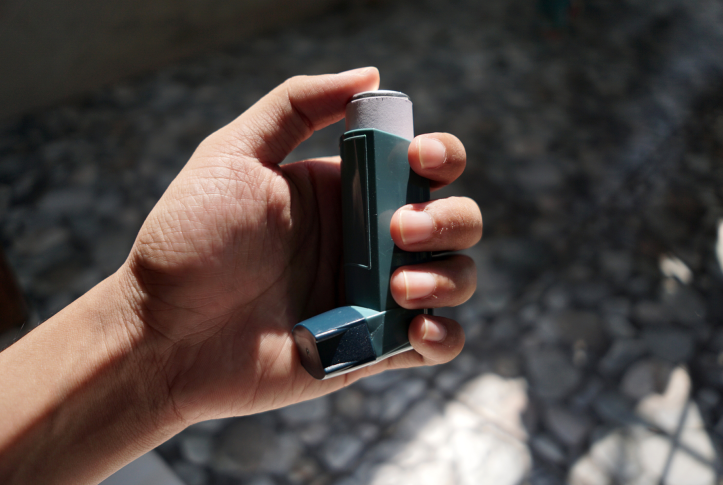More than 34 million Americans live with a chronic lung disease; more than 25 million have asthma. Because of increases in air pollution and allergens like mold and pollen, as well as other effects of climate change, the rates of respiratory diseases are rising. In the U.S., the standard treatment for asthma is a pressurized metered-dose inhaler, but these devices have a marked carbon footprint that is contributing to climate change.
In this post, we’ll examine how other countries have worked to reduce emissions from inhalers while effectively treating respiratory diseases, and steps that U.S. policymakers, health care systems, and industry leaders could take to do the same.
A Greener Inhaler
In 2020, metered-dose inhalers made up 75 percent of inhalers in use in the United States, with the equivalent emissions impact of driving half a million cars for a year. The outsized carbon footprint of these inhalers is a result of hydrofluoroalkanes (HFAs), the active propellant that administers the medication in the inhaler. HFAs were an improvement from the original propellant in metered-dose inhalers, chlorofluorocarbons (CFCs), which damage the ozone layer. HFAs have no impact on the ozone layer but still have 1,000 times the global warming potential of carbon dioxide.
There is, however, a clinically effective and more environmentally friendly alternative: a dry-powder inhaler. Dry-powder inhalers are breath-controlled and do not contain a propellant. They result in 95 percent fewer carbon emissions compared to metered-dose inhalers. Efforts to reduce carbon emissions have led health care systems in some countries to start prescribing dry-powder inhalers in place of metered-dose inhalers.
Global Examples
Sweden has largely replaced metered-dose inhalers with dry-powder inhalers. By 2019, only 10 percent of inhalers in use in the country were metered-dose. England’s National Health Service (NHS) has also taken steps to mitigate the impact of metered-dose inhalers, which are estimated to be responsible for 3 percent of total emissions by the NHS. To mitigate the impact of inhalers, the NHS removed the two most carbon-intensive inhalers from formularies, agreed to designate dry-powder inhalers as the default treatment for patients 12 and older, and invested in inhaler technique education to prevent excess emissions.
The British pharmaceutical industry has also taken steps to reduce impact from metered-dose inhalers. Pharmaceutical manufacturer GSK stated that metered-dose inhalers were responsible for 45 percent of their carbon emissions and they were working to develop a new, lower-emissions propellant. AstraZeneca is also developing a propellant that will not contribute to global warming. If successful, it is expected to be available by 2025.
Swapping Inhalers Is Not a Simple Solution
Why have policymakers and health care systems in the U.S. not meaningfully addressed the impact of inhalers?
One possible reason is that while most adults can make the swap from a metered-dose inhaler to a dry-powder inhaler, many children and elderly people with limited lung capacity may not be able to generate enough force to effectively use a dry-powder inhaler, and therefore still require a metered-dose inhaler.
Patient preferences also could explain the clinical hesitance to switch. A 2017 study found that approximately 60 percent of patients preferred using a metered-dose inhaler compared to 30 percent who preferred a dry-powder inhaler.
Another barrier to addressing this issue is that the potential economic impact of switching to dry-powder inhalers in the U.S. is unclear. Some studies suggest major cost savings while others warn of an increase in costs to both health care payers and patients. This is compounded by the uncertainty around how pharmaceutical companies and insurers will respond to this change. For example, in the U.S., pharmaceutical companies hold patents on inhaler technologies and used the switch from inhalers with CFCs to maximize profits.
Finally, despite their large contribution to emissions from the health care sector, inhalers themselves account for only a small portion of all U.S. carbon emissions when compared to emissions from other sources like transportation, manufacturing, and agriculture, meaning health care leaders and policymakers have not prioritized action in addressing their impact. However, as many health care systems in the U.S. have pledged to reduce their carbon emissions by 50 percent by 2030, replacing inhalers will become a critical step in achieving that goal.
How the U.S. Can Start to Mitigate the Impact of Inhalers
Supporting a shift to a lower-carbon inhaler will help the United States in reducing carbon emissions in the health care sector. Actions that policymakers, health care systems, and industry leaders in the U.S. could take, along with a large-scale move to dry-powder inhalers, include:
- promotion of and investment in research and development of new, lower-emissions inhaler technologies
- improvement of overall care standards and commitment to patient education to improve patients’ inhaler technique and reduce excess emissions because of poor technique
- investment in proper disposal and recycling of inhalers
- further economic evaluations to determine cost-effective strategies to replace metered-dose inhalers.
As climate change worsens, rates of asthma and other respiratory illnesses — and use of inhalers — are expected to rise. By taking steps now, the U.S. health care system could work toward reducing emissions and mitigating the negative impact on population health.

